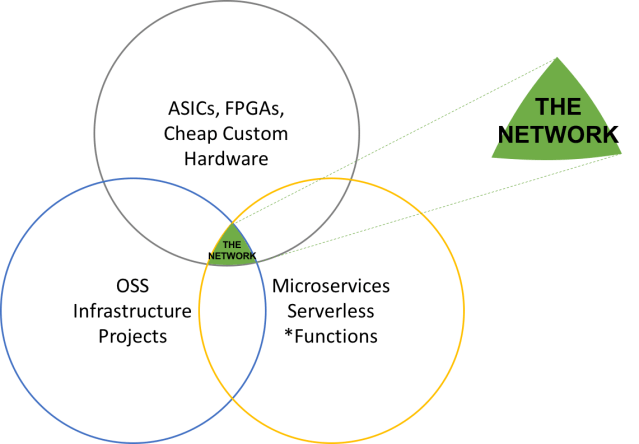This post is the second in a series: To read them in order, start here.
There are three trends that I have seen happening over the past few years that are indirectly or directly influencing the future of networks; The first is the use of FPGAs and ASICs to solve problems around distributed applications and network loads(specifically I’m thinking of Bing/Azure and several AI projects — including one that chose to go down the ASIC path — Google. The other path that is intriguing is of PISA by Barefoot Networks, which seems on a positive trajectory.
This has been driven by the need for greater performance and better efficiencies in the data center at extreme scale. These efficiencies also translate into very large amounts of capex that ends up being saved. The use of custom hardware in conjunction with software, brings much better returns because of the purpose built nature (which brings increased efficiency and/or performance). This could even be seen as what would be the equivalent of VMware shipping VMware Workstation. This technology provided the foundation for the virtualization transformation of the last decade, all based on making more efficient use of server hardware sitting in datacenter already. Yes, virtualization brought many many other benefits, but the story that initially took hold was better utilization of hardware.
Another trend has been the explosion of infrastructure technologies and projects, of which most are OSS. These projects include a wide array of technological building blocks that have been contributed by many of those same large cloud companies mentioned earlier. However, in addition to these large cloud companies, many other large software companies and some fast growing small companies like Hashicorp, have also developed and released infrastructure technologies (Infrastructure as Code). Technologies such as:
- Message Busses/Event/Job Queues & gRPC & Aeron
- Cluster/State Consensus & Messaging
- Caches (Redis, Ehcache, Memcached, Hazelcast, Freecache, to name a few)
- Service Discovery & Brokers
- Data Streaming and Stream Processing
- Message Serialization/Deserialization
- ….
There is a specific category that I would like to directly address:
Network gear has stagnated so much, that pure software infrastructure has taken over a large swath of functionality that should live in software on network equipment. This isn’t a knock against any of the projects above, they are all quite innovative and are answering an obvious unmet need. This is another key indicator that we need to change the nature of the network and how it integrates with what runs on it.
The final trend is that of microservices and serverless aka (lambda/azure functions/cloud functions). This is increasing in popularity very quickly by proponents (and with good reason). What is intriguing about the technology, is that you can write very small amounts of logic/code to interconnect the equivalent of lego blocks of services and infrastructure functionality. This has the same risk as microservices, in that there is also some complexity to be managed (especially if the implementation is not well thought-out upfront). However the benefits in speed of development, scalability and delivery outweigh the costs in most cases from what we have seen so far.

So how does all this involve the future of networks? Read Part 3 of this series tomorrow to find out what the future of networks is pointing to.